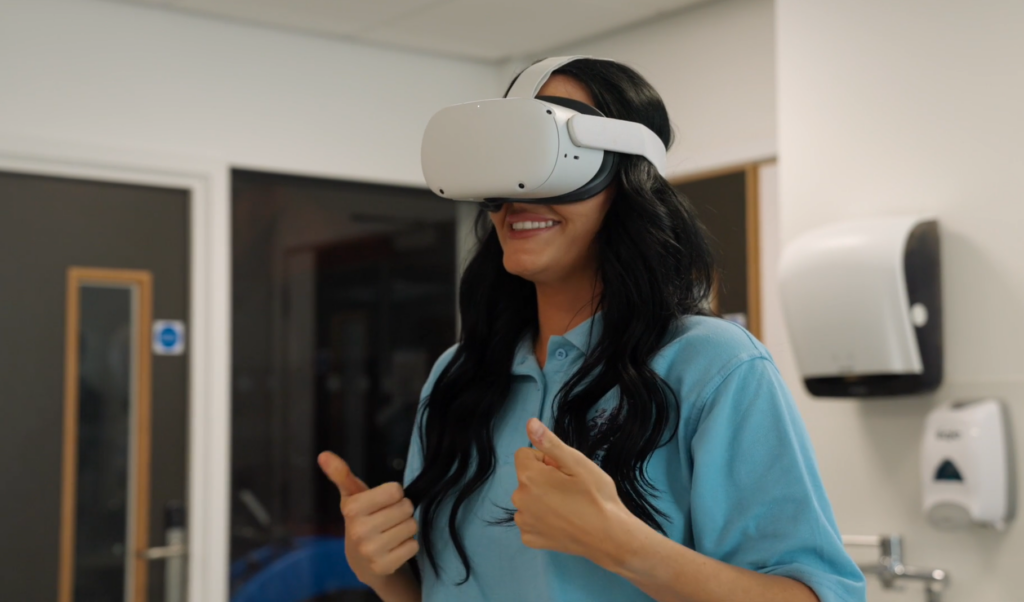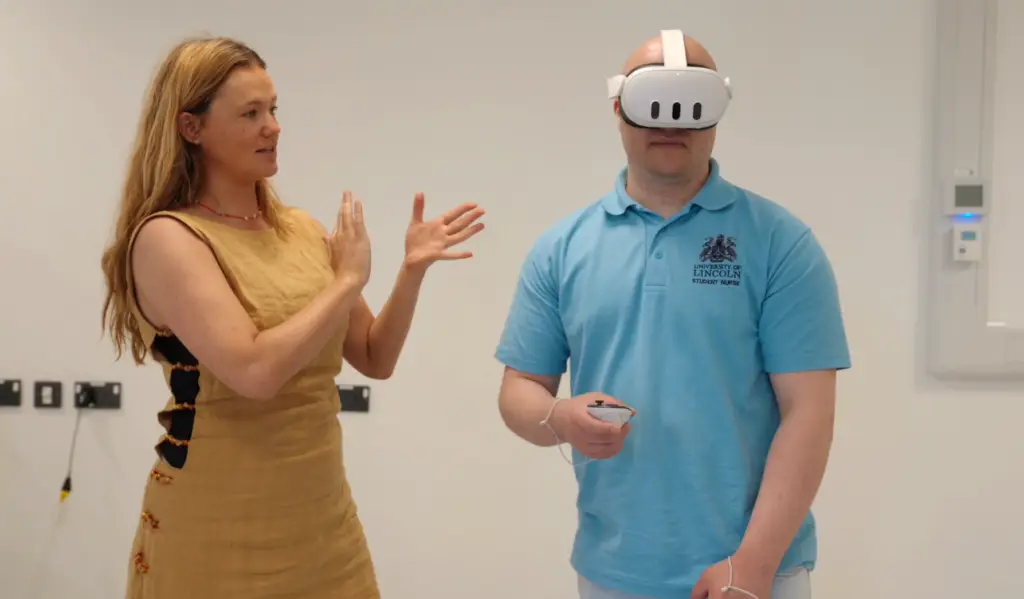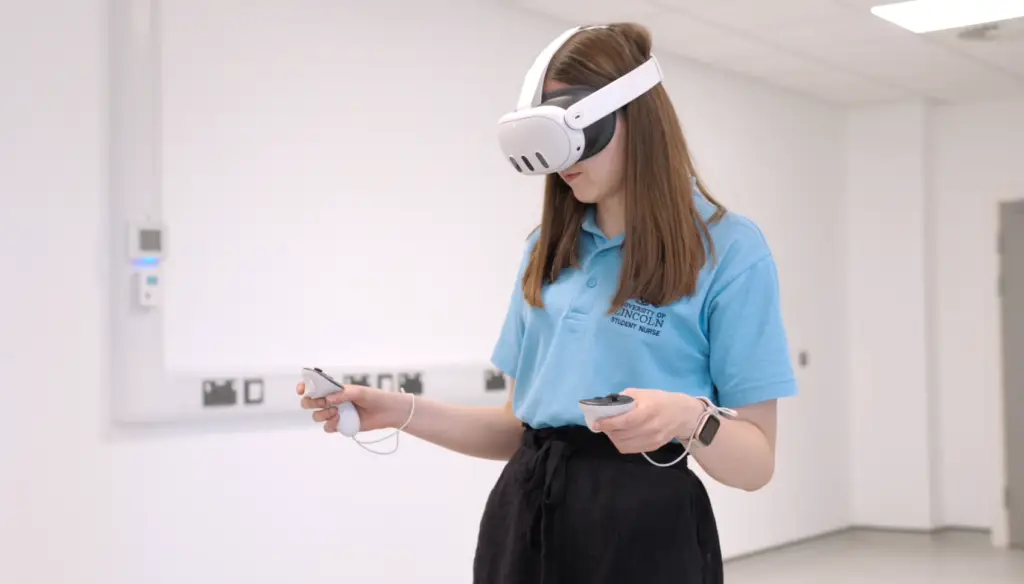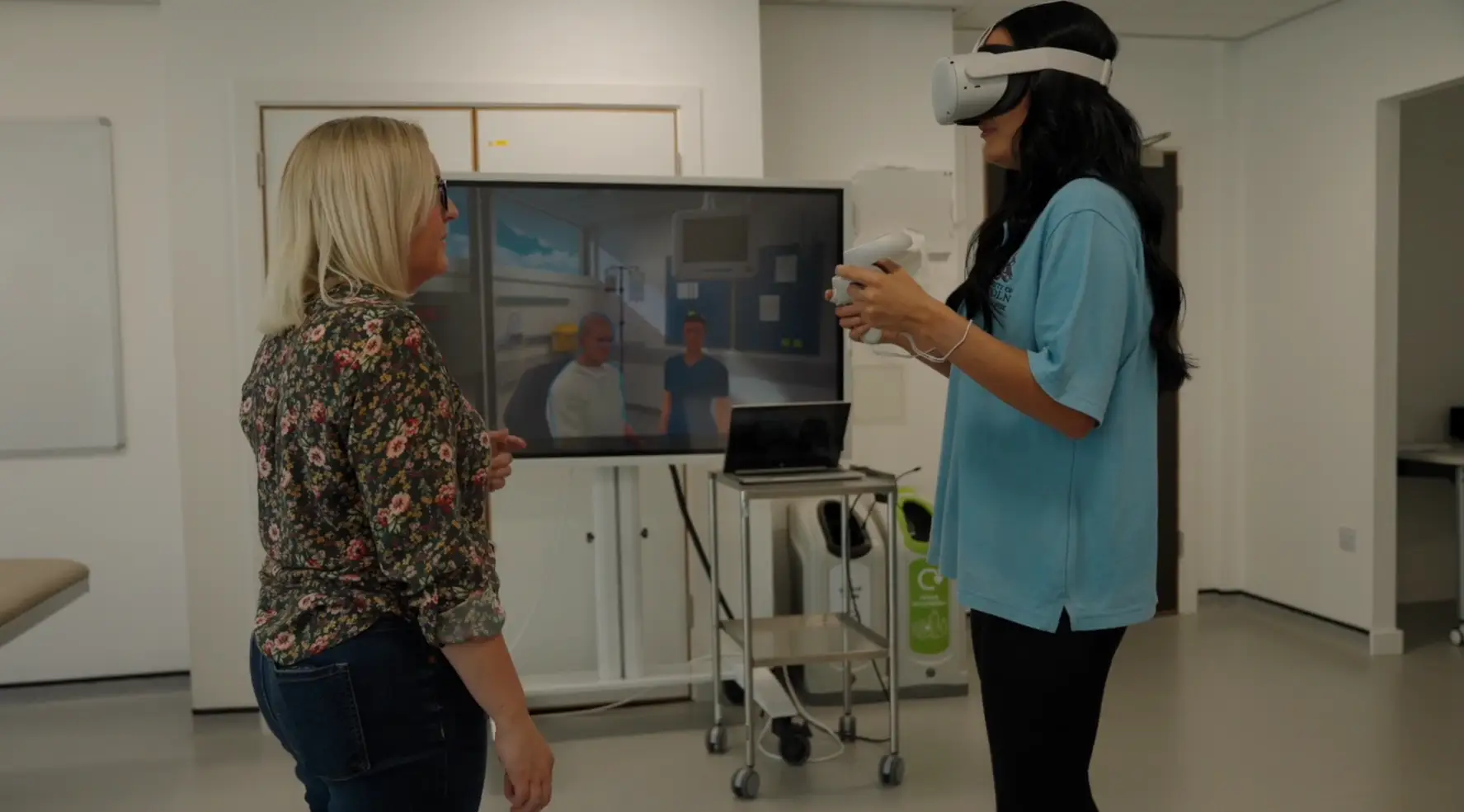The University of Lincoln, a world-leading institution, is at the forefront of embracing technology to innovate nursing education and skill assessment.
With the support of the NHS and HEE encouraging the use of technology to enhance learning opportunities, the team at Lincoln looked to alternative teaching methods to engage their students and optimize their assessment processes.
At the core of nursing is an ability to recognize when patients are acutely unwell, intervening quickly and effectively.
The team at Lincoln needed virtual reality (VR) scenarios that reflect these real-life experiences with realistic and robust simulations. They were also seeking an alternative method to conduct skills assessments while saving time and critically – without sacrificing quality.
As a result, the team selected Oxford Medical Simulation (OMS) to provide the VR platform that 2nd year BSc students work with, resulting in a workload that was “drastically reduced” and saving 200 hours of staff time.
How the University of Lincoln implemented VR for nursing assessment
Pre-exam day
Scenarios were released to students at the beginning of the module, and students could use these simulations as they saw fit leading up to assessment.
This helped learners to get familiar with navigating the virtual environment, easing any anxieties about where to go to conduct a chart review, how to administer medication, and where to find key items or equipment they might need to use when conducting patient care.
Additionally, easy access to repeatable scenarios gave students the opportunity to engage their clinical reasoning skills, reflect on their performance with feedback, and identify any knowledge gaps they needed to work on ahead of exams.
As exam day approached, students were able to hone in on the skills they needed to work on individually. For example, while one student may need to work on time management, another may need to work on interprofessional communication and delegation.
With this approach, students were able to get individualized feedback and engage in deliberate practice, getting more information about their own clinical performance ahead of assessments.
Exam day
On the day of the assessment, students conducted a simulated patient case using an OMS scenario selected by the Lincoln team.
They were assessed on a range of skills, including:
- Conducting a physical assessment
- History taking
- Patient communication
- Interpreting data from test results
Students moved independently through the case as team members observed their ability to collect relevant information, observe their patient and analyze cues, and provide appropriate care.
As learners gathered information, they were also assessed on their ability to collate data, putting together a clear clinical picture for the virtual patient.
They then needed to conduct a timely handover and treat the patient effectively before exiting the room.
VR compared to traditional methods
Prior to the use of OMS, the University of Lincoln conducted OSCEs in-person using traditional methods.
As is common for in-person simulation, this required a significant number of staff, as well as a need for enough space, effective scheduling, and ongoing support.
Typically, OSCEs conducted in this way were run over the course of about one week.
With OMS, the team at Lincoln were able to run the entirety of their OSCEs in less than half a day, with only two people supporting the whole process.
According to Michael Rowe, Associate Professor (Digital Innovation in Health and Social Care), this approach “made a massive difference to the way we think about assessment in this program”.
The VR assessment experiences of nursing students
When it was first announced that OSCEs would be conducted using virtual reality, there was a range of responses from students.
Some were cautiously optimistic, others were more concerned, while some were excited by the idea.
However, many of the concerns of the students were related to general exam anxieties which would’ve been asked about with traditional OSCEs. These fears were easily offset once students gained early access to the scenarios and saw the ease of use with the platform.
Following the VR-focused OSCEs, students reported it was a system they really appreciated, even requesting more scenarios like the ones used in practice and in assessment.
One student, Kenneth Ward, highlighted the case revolving around epilepsy, as it “really tested your skills”. Another student, Francesca Ollier, highlighted the same scenario for another reason – it exposed her to a situation she hadn’t yet experienced in a clinical setting, and it prepared her for what to do when a seizure takes place unexpectedly.
One student, Ellie Mytton, reported that she found VR simulations to be particularly helpful as a visual learner with dyslexia. She was able to learn by “doing it before you’re actually in practice”, which helped her feel more confident going into exams than other, more traditional methods.
Francesca Ollier reported that, as a mother, having access to scenarios at home was a big help in supporting her learning process while she balanced personal and academic life.
Compared to more traditional teaching methods, students shared a variety of thoughts, highlighting the repeatability of VR giving them “far more repetition than you’d normally get”, with one student stating “I think I got a higher score than I would have otherwise”.
When it comes to the ability to engage in clinical decision making in VR, Kenneth feels “you can improve massively from VR”, and that’s not the only skill students felt improved.
They also cited communication as a skill that they felt more confident in, as they were able to practice when to call and escalate for additional support from the wider team. Having no prior experience of this, one student reported that they now feel confident in what to do and how to recognize when a patient may have sepsis.
Summing up the student experience, Francesca said, “By the end of it, I felt really empowered and encouraged”.

Data & findings
Because of the data and analytics inherent to the OMS platform, faculty have seen exciting insights into student performance.
Compared to previous years, overall results for students have improved. That is to say, more students are coming out with higher grades than before.
While this can be due to a number of factors, Amy Rennison, Senior Lecturer Nursing, believes some of this is attributable to the ability to practice repeatedly and robustly.
In analyzing data from OMS, Rennison identified correlations between students who performed well and the amount of practice time they put in.
Rennison looked at the spread of how students performed, looking at how many students passed and how well they passed. The usage data for students indicated that students who practiced more frequently in OMS scenarios ended up with higher assessment scores.
Importantly, this repeatability was highlighted by both students and faculty as a means for better understanding and preparation leading into testing.
The ability to repeatedly practice simulations is not something that is typically feasible when conducting physical simulation and has only been possible through the flexibility and accessibility of the OMS platform.
So far, students have run over 9,000 hours worth of simulation, which faculty feel is a direct reflection of the high level of engagement from students with this learning method.
Faculty are also able to use data from the OMS platform to provide even more individualized feedback to students.
They’re able to pinpoint down to the second where students took a wrong turn or missed an important action. This helps them to narrow down the skills that students need to improve upon before being assessed.
Per Rennison, the data and analytics provided by the OMS platform has been “really invaluable”.

Benefits of using VR for assessment
Simulation technologists are also key players in conducting simulation for students.
Katie Marshall, Senior Clinical Skills Simulation Technician, knows exactly the work, time, and resources that go into simulation days.
Pre-OMS process
Prior to using OMS, simulation was often conducted using physical or manikin-based simulation.
This process is deeply involved, and while necessary and a core component of learning, it does come with its challenges.
Previously, Katie and her team kept a time table of all assessments in their clinical skills planner. This involved coordinating time slots, as multiple groups required time in the clinical lab space.
Their team is responsible for balancing the clinical skills practicals alongside assessments, ensuring everyone is able to get time in the space to meet their learning objectives.
In addition, this team is responsible for the setup and breakdown of equipment in the skills lab.
When conducting in-person simulations, the simulation technologists must set up and, subsequently, reset each station as students move through the process.
They’re also the go-to people for support during simulations and must be present to help as any technological issues arise.
With OMS process
From a logistical standpoint, the software was easily set up and support from OMS was accessible and quick to respond to any questions.
Once the setup process was completed, scenarios were deployed to students without issue, and learners could then access scenarios at any time from their laptops or PCs, whether at school or at home.
To deploy new scenarios to new students, Katie and her team simply import all users into the software with a quick and simple template provided by OMS.
They then assign groups and scenarios to those groups, which only takes about 30 minutes total. Then, scenarios are released, which takes about 5 minutes.
On the day of assessment, Katie and her team did about 5 minutes of technical support, released the simulations, and any further support needs were easily addressed using the chat function in the OMS platform.

Resources saved & staff benefits
As a result of this new process, staff have saved hours of their time around conducting simulations.
There’s now a reduced need for setup and breakdown, and because of the online platform for VR simulations, this has freed up about 200 hours of clinical skills space time.
With all that time gained from using OMS, staff are able to focus on other deep work and dedicate more time to supporting clinical skills simulations, working on the finer details of simulation, and are able to spend “more time in areas to further better what we provide.”
As a faculty member, Amy Rennison and her team have also experienced a “dramatic reduction in staff time” to run an OSCE for a large cohort.
This time saved comes in the form of staff hours – there is much less prep time involved, meaning faculty have more time to focus their attention on the assessment of student skills.
Critically, this has not come at the cost of the student experience. Quite the opposite is true: “In many ways, the student experience was enhanced”.
Future plans
With OMS scenarios, faculty are able to prepare students for the real world clinical setting, providing guaranteed experiences that students may not otherwise face in a clinical placement.
Unpredictable situations, like arrest scenarios, have been particularly valuable to students and faculty alike. Students are able to apply their skills in a safe environment, with support, and repeat it as much as needed.
With time, students build confidence they’re able to bring with them as they conduct patient care in the real world.
With such positive findings, the team at Lincoln look forward to using this method of assessment again in the future, and seek to expand VR use into other programs.
As the initial assessment was done with 2nd year BSc students, Rennison hopes to use OMS with all pre-registration learners. According to Rennison:
“I can use this software to support a first year student who’s learning the basics of nursing all the way up to an experienced specialist critical care nurse, give them completely different scenarios with different expectations, but I’m still using the same software.”
Her advice to any institution looking to use VR for an OSCE?
“Absolutely, just go for it!”

